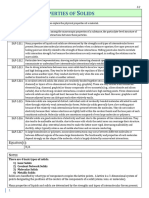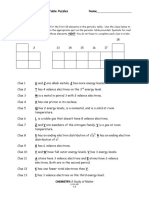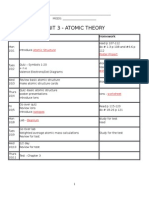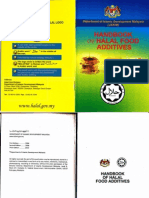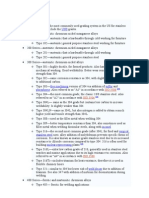Periodic Table Trends Project
Periodic Table Trends Project
Uploaded by
api-215898557Copyright:
Available Formats
Periodic Table Trends Project
Periodic Table Trends Project
Uploaded by
api-215898557Original Title
Copyright
Available Formats
Share this document
Did you find this document useful?
Is this content inappropriate?
Copyright:
Available Formats
Periodic Table Trends Project
Periodic Table Trends Project
Uploaded by
api-215898557Copyright:
Available Formats
PERIODIC TABLE TRENDS
Step 1: Complete the squares for each
element by adding the atomic number,
name, and atomic mass.
Write the atomic number at the top of the square.
Write the atomic name under the symbol.
Write the atomic mass at the bottom of the square.
____
P = ____
Be
N = ____
E = ____
Step 2: Determine the number of electrons, protons,
__________
Bohr
Diagram Dot Structure
______
and neutrons in each statement.
Be
Step 3: Create a Bohr diagram for each element.
Metal Nonmetal Metalloid
Solid
Gas
Step 4: Draw a Lewis Dot Structure for each element.
Step 5: Show whether the element is a metal, nonmetal, or metalloid by circling the correct
response. Also determine if the element is a solid or gas by circling the correct choice.
Step 6: Use the following colors to shade in the square for each element. You should ONLY
color in the small square in the upper left-hand corner and not the entire card.
Green Li and Na
Pink O and S
Blue Be and Mg
Purple F and Cl
Orange B and Al
Red C and Si
Brown N and P
Yellow He, Ne, and Ar
White - H
Step 7: Cut the cards apart and arrange according to atomic number in the pattern shown
below. Once you have the cards arranged in the correct order, glue them to a large sheet of
construction paper.
1
10
11
12
13
14
15
16
17
18
Step 8: Put a title on your table.
Step 9: Make a key for each color with the name of the group for that column.
Step 10: Write the column number at the top of each group and the period number on the left
side of the table. Be careful, column numbers are not in order from 1-18 and the transition
metals, columns 3-12 are not on the table.
Step 11: Draw the red zigzag line that separates the metals from the nonmetals.
Step 12: Answer the questions on the worksheet using the information on your periodic table.
Copyright: T. Trimpe 2002 and M. Robinson 2007
PERIODIC TABLE TRENDS WORKSHEET
1. Which elements have a complete outer shell of valence electrons?
____________________, ____________________, ____________________
2. Which elements have only one valence electron?
____________________, ____________________, ____________________
3. What do you know about the valence electrons as you move left to right across a period or
row? (Na, Mg, Al, Si, P, S, Cl, Ar)
4. What do you notice about the valence electrons as you move down a group or column? (H,
Li, Na)
5. What do you notice about the number of energy levels (shells) as you move down a group or
column? (H, Li, Na) or (He, Ne, or Ar)
6. Complete the table below about the group (family) names, valence electrons, and names of
elements in that group.
Group
Group Name
Number of
Names of Elements in that Group
Number
Valence Electrons
1
2
13
14
15
16
17
18
7. Hydrogen is placed in group 1 but is not an alkali metal. Why do you think the gas hydrogen
is in this group?
8. What trends do you notice about the atomic number and atomic mass as you move left to
right across your periodic table?
Atomic number
Atomic mass
Copyright: T. Trimpe 2002 and M. Robinson 2007
9. What does the group number help tell you in columns 1, 2, 13, 14, 15, 16, 17, and 18?
10. What does the period number tell you about the electron levels?
11. How do find the number of protons and electrons in an element?
12. How do you find the number of neutrons in an element?
13. What is the maximum number of electrons an element can have on the
First (inner) level ______
Second level ______
Third level ______
14. What two particles are found in the nucleus?
15. What do the dots on the Lewis structure represent?
16. Write the names of all the elements that are metals on the poster?
17. Write the names of all the elements that are nonmetals on the poster?
18. Write the names of all the elements that are metalloids on the poster?
19. Write the names of all the elements that are solids on the poster?
20. Write the names of all the elements that are gases on the poster?
Copyright: T. Trimpe 2002 and M. Robinson 2007
Name ________________________________________ Date _______________ Period _________
PERIODIC TABLE TRENDS CHECKLIST
Standard: SPS1a: Students will investigate our current understanding of the atom
Standard SPS4: Students will investigate the arrangement of the periodic table.
Science Processing Skills: SCSH 9 c: Building vocabulary knowledge.
Criteria/Elements/Performance Indicators
Not Yet
Squares
Did you write the correct atomic number for each element?
Did you write the correct element name for each element?
Did you write the correct atomic mass for each element?
Did you write the correct number of protons, neutrons, and electrons
for each element?
Did you correctly draw the Bohr model for each element?
Are the electrons in the levels arranged in pairs?
Did you correctly draw the Lewis structure for each element?
Did you determine if the element was a metal, nonmetal, or
metalloid?
Did you determine if the element was a solid or a gas?
Is each square shaded in with the correct color?
Did you shade the small square and not the larger one?
Poster
Have you arranged the elements according to the diagram in the
directions?
Have you glued all of them down?
Are the cards arranged neatly in rows?
Is your poster free of smudges and other stray marks?
Does your poster have a key to identify the group name of each
column
Does your poster have a title?
Did you put your name on the poster?
Questions
Have you answered each question? (Get help if needed)
Is your name on the question sheet?
Copyright: T. Trimpe 2002 and M. Robinson 2007
Complete
Name ________________________________________ Date _______________ Period _________
Periodic Table Trends Project Rubric
Standard: SPS1a: Students will investigate our current understanding of the atom
Standard SPS4: Students will investigate the arrangement of the periodic table.
Science Processing Skills: SCSH 9 c: Building vocabulary knowledge.
Criteria
Poster
Has a title
Has a key listing group names
and is color coded
Each group (column) is
numbered
Each period (row) is numbered
Writing in the small squares is
readable over the colors.
A red zigzag line separates the
metals and nonmetals
The electron dots on the Bohr
model are easily seen and can
be counted
The electrons on the Bohr
model are in pairs
The elements are determined
to be metals, nonmetals, or
metalloids
The elements have been
classified as solids or gases
There are no written errors on
the poster cards
Appearance
Rows and columns are aligned
Handwriting in squares is neat
and readable
Squares are glued down
securely
Poster is free of smudges and
stray marks
Color
Key matches the columns on
the poster
Each card only has the small
square colored
All columns are the same color
except hydrogen
Score
Includes
6 of these
criteria
Includes 78 of these
criteria
Includes 910 of these
criteria
Includes 11
of these
criteria
______X 3
(12)
Includes
1 of these
criteria
Includes 2
of these
criteria
Includes 3
of these
criteria
Includes 4
of these
criteria
______X 2
(8)
Includes
the first
two criteria
with 1-2 of
the groups
colored
correctly
Includes
the first
two criteria
with 3-4 of
the groups
colored
correctly
Includes
the first
two criteria
with 5-6 of
the groups
colored
correctly
Includes
the first
two criteria
with 7-8 of
the groups
colored
correctly
______X 3
(12)
Copyright: T. Trimpe 2002 and M. Robinson 2007
Identifier Square on Card
Atomic number written
correctly
Element name written
correctly
Atomic mass written correctly
Protons, Neutrons, & Electrons
The number of protons,
neutrons, and electrons are
written on the cards
Remember: The number of
protons and electrons equals the
atomic number. Atomic mass
minus the atomic number = the
number of neutrons
Bohr Diagram
The inner level contains only
two electrons
The outer most level contains
only the valence electrons
Second energy level only has 8
electrons
The number of electrons must
equal the proton number
Lewis Dot Structure
Lewis Dot Structures are
correctly drawn on the cards
Start at the top of the symbol and
place a dot. Go clockwise around
the four sides of the symbol until
all valence electrons are placed.
Metals, Nonmetals, & Metalloids
Each elements is classified as a
metal, nonmetal, or metalloid
Solid or Gas
Each element is classified as a
solid or gas.
1-13 items
(atomic
number,
element
name and
atomic
mass) are
written
correctly
1-13 items
written
correctly
14-27 items 28-41 items 42-54 items
(atomic
(atomic
(atomic
number,
number,
number,
element
element
element
name and
name and
name and
atomic
atomic
atomic
mass) are
mass) are
mass) are
written
written
written
correctly
correctly
correctly
14-27 items 28-41 items 42-54 items
written
written
written
correctly
correctly
correctly
______X 3
(12)
10 or less
of the Bohr
diagrams
are correct
11-14 of
the Bohr
diagrams
are correct
15-17 of
the Bohr
diagrams
are correct
18 of the
Bohr
diagrams
are correct
______X 3
(12)
6 of the
lewis dot
structures
correct
7-10 of the
lewis dot
structures
correct
11-14 of
the lewis
dot
structures
correct
15-18 of
the lewis
dot
structures
correct
______X 3
(12)
13 or less
elements
classified
correctly
13 or less
elements
classified
correctly
14-15
elements
classified
correctly
All 18
elements
classified
correctly
16-17
elements
classified
correctly
16-17
elements
classified
correctly
All 18
elements
classified
correctly
All 18
elements
classified
correctly
______X 2
(8)
______X 4
(16)
______X 2
(8)
Total Points: ______________
Student Signature ____________________________________ Date: _______________________
Parent Signature _____________________________________ Date: _______________________
Copyright: T. Trimpe 2002 and M. Robinson 2007
You might also like
- POGIL Net Ionic Equations - SDocument5 pagesPOGIL Net Ionic Equations - Sdemyeets64No ratings yet
- 3.2 Properties of Solids StudentDocument7 pages3.2 Properties of Solids StudentZachary Daniel UyNo ratings yet
- CTSC Matric Masterclasses Acid and Bases 2020-1Document13 pagesCTSC Matric Masterclasses Acid and Bases 2020-1mxolisi mkhumaneNo ratings yet
- Directed Reading English Classification of Matter EditableDocument4 pagesDirected Reading English Classification of Matter EditableJustinNo ratings yet
- Atoms and Molecules Webquest - Arya SoniDocument7 pagesAtoms and Molecules Webquest - Arya SoniArya SoniNo ratings yet
- Color Coding The Periodic Table BLM 1Document2 pagesColor Coding The Periodic Table BLM 1api-94846453No ratings yet
- 5 Isotope Practice WorksheetDocument1 page5 Isotope Practice Worksheetapi-369690183No ratings yet
- Stereochemistry Worksheet LabDocument3 pagesStereochemistry Worksheet LabDaniel McDermott0% (1)
- Atomic Structure WorksheetDocument2 pagesAtomic Structure WorksheetAryan Agrawal50% (2)
- Mgo LabDocument3 pagesMgo Labapi-336093393No ratings yet
- Lewis Dot Structures of Atoms and Ions: Valence Electrons Noble Gas StabilityDocument6 pagesLewis Dot Structures of Atoms and Ions: Valence Electrons Noble Gas StabilityAndrew CabreraNo ratings yet
- Atoms and The Periodic Table Study Guide AnswersDocument10 pagesAtoms and The Periodic Table Study Guide Answersapi-267855902100% (1)
- Create An Element Trading Card ProjectDocument2 pagesCreate An Element Trading Card Projectjkwong1331No ratings yet
- Periodic Table BasicsDocument3 pagesPeriodic Table Basicschabries100% (4)
- Color Coding The Periodic TableDocument4 pagesColor Coding The Periodic TableClaire O'MahonyNo ratings yet
- Periodic Table PuzzlesDocument1 pagePeriodic Table Puzzlesrachna guptaNo ratings yet
- Bohr Diagrams, Valence Electrons, Lewis Dot StructuresDocument4 pagesBohr Diagrams, Valence Electrons, Lewis Dot StructureschabriesNo ratings yet
- Bohr Models Worksheet 2Document4 pagesBohr Models Worksheet 2Amiyah ThompsonNo ratings yet
- Density Graphs Assignment: SNC1D1 Chemistry Date: NameDocument6 pagesDensity Graphs Assignment: SNC1D1 Chemistry Date: NameAmeera Vania100% (1)
- SCH3U Chemistry Unit 1 MC ReviewDocument16 pagesSCH3U Chemistry Unit 1 MC Review1moeezafNo ratings yet
- Chemistry SOL Review: Part 2: Atomic Structure and Periodic RelationshipsDocument42 pagesChemistry SOL Review: Part 2: Atomic Structure and Periodic RelationshipshelperforeuNo ratings yet
- MY3 AtomsDocument6 pagesMY3 AtomserikaNo ratings yet
- The Periodic Law NotesDocument36 pagesThe Periodic Law NotesAref DahabrahNo ratings yet
- Bonding Basics CovalentDocument2 pagesBonding Basics Covalentwosli350% (2)
- Intro To Isotopes Phet Lab: Hydrogen: H Carbon: C Oxygen: O Neon: NeDocument5 pagesIntro To Isotopes Phet Lab: Hydrogen: H Carbon: C Oxygen: O Neon: NeChaewoo KimNo ratings yet
- 6 4IonizEnergyDocument1 page6 4IonizEnergyShehbaz YaseenNo ratings yet
- Naming Covalent CompoundsDocument9 pagesNaming Covalent Compoundsapi-234891239No ratings yet
- Third Form Chemistry Packet #2Document11 pagesThird Form Chemistry Packet #2Lizbeth ChiNo ratings yet
- POGIL Electron Configuration and OrbitalsDocument10 pagesPOGIL Electron Configuration and Orbitals776pmsfq2fNo ratings yet
- Study Guide For Periodic Table TESTDocument19 pagesStudy Guide For Periodic Table TESTHarani ThillainathanNo ratings yet
- Periodic Table Online Scavenger HuntDocument6 pagesPeriodic Table Online Scavenger HuntAaya Alowaiyesh0% (1)
- AP Chemistry Bonding Help Sheet: 2, (Diamond)Document6 pagesAP Chemistry Bonding Help Sheet: 2, (Diamond)Weiyu TongNo ratings yet
- Lab-Analysis of Circular MotionDocument6 pagesLab-Analysis of Circular MotionSouvik GhoshNo ratings yet
- CP 17 Lab 2 Build An Atom PhET SimulationDocument4 pagesCP 17 Lab 2 Build An Atom PhET SimulationAlexandra. NNo ratings yet
- Secondary 2 - Chemistry - Lesson 3Document19 pagesSecondary 2 - Chemistry - Lesson 3Michelle PannieNo ratings yet
- Fill in The Blanks For The Elements in This Chart and Answer The Questions That FollowDocument2 pagesFill in The Blanks For The Elements in This Chart and Answer The Questions That Followmr_vinderackNo ratings yet
- 2.11 Counting Atoms Practice WorksheetDocument2 pages2.11 Counting Atoms Practice WorksheetzahraaNo ratings yet
- Minerals Lesson 4Document7 pagesMinerals Lesson 4api-250800467No ratings yet
- ChemQuest 2001 27Document4 pagesChemQuest 2001 27Aaron Thai-Hung Pham0% (1)
- ElementBuilderSEDocument5 pagesElementBuilderSEjiang100% (1)
- Reading Comprehension Worksheet - 10th GradeDocument4 pagesReading Comprehension Worksheet - 10th GradeAngelica Calamba CalicaNo ratings yet
- Sc10 - Worksheet On Atoms and IonsDocument6 pagesSc10 - Worksheet On Atoms and IonsAnmol AgarwalNo ratings yet
- Simple Binary Ionic Compounds: Nomenclature Worksheet 2Document4 pagesSimple Binary Ionic Compounds: Nomenclature Worksheet 2NameNo ratings yet
- Test1 ReviewDocument11 pagesTest1 ReviewPrathyan GaraNo ratings yet
- Electron Configuration of AtomsDocument10 pagesElectron Configuration of AtomsDaniel BerryNo ratings yet
- Nachemte 142Document8 pagesNachemte 142MuhammadNo ratings yet
- Periodic Table of ElementsDocument40 pagesPeriodic Table of ElementsAwais ArshadNo ratings yet
- SNC 1D0 Name: - Atoms & Elements Date: - Unit TestDocument5 pagesSNC 1D0 Name: - Atoms & Elements Date: - Unit TestuyenNo ratings yet
- Ionic Covalent Bonds PractDocument2 pagesIonic Covalent Bonds PractRina NoviantiNo ratings yet
- Section 7.4 Metallic Bonds and The Properties of MetalsDocument10 pagesSection 7.4 Metallic Bonds and The Properties of Metalslaelatul mutoharohNo ratings yet
- Valence Electrons and Lewis Dot Structure Worksheet PDFDocument2 pagesValence Electrons and Lewis Dot Structure Worksheet PDFjimmy dela cruzNo ratings yet
- Magnets Study GuideDocument3 pagesMagnets Study Guideapi-284403216No ratings yet
- Packet Unit 3 - Atomic Structure-Answers ChemistryDocument11 pagesPacket Unit 3 - Atomic Structure-Answers ChemistryMario J. KafatiNo ratings yet
- POGIL Avg Atomic Mass KEYDocument4 pagesPOGIL Avg Atomic Mass KEYbobNo ratings yet
- 3.1 Classifying Matter NotesDocument5 pages3.1 Classifying Matter NotesJam Uly GastyNo ratings yet
- Lewis StructureDocument3 pagesLewis StructurerennylowNo ratings yet
- Chapter 2 Lesson 2.1 MineralsDocument57 pagesChapter 2 Lesson 2.1 MineralsPrincess Jaymee SuarezNo ratings yet
- Bohr Model-Lewis DotDocument5 pagesBohr Model-Lewis DotCandice AllenNo ratings yet
- snc1d Chemistry Unit ReviewDocument6 pagessnc1d Chemistry Unit Reviewapi-54435418No ratings yet
- 3 Cracking The Periodic CodeDocument5 pages3 Cracking The Periodic Codesienna bNo ratings yet
- PT ColoringDocument4 pagesPT ColoringSarahNo ratings yet
- Journal Entries McewanDocument11 pagesJournal Entries Mcewanapi-215898557No ratings yet
- My Internet ThingDocument14 pagesMy Internet Thingapi-215898557No ratings yet
- Test Corrections DirectionsDocument1 pageTest Corrections Directionsapi-215898557No ratings yet
- India Spain Germany Canada: Hindi, English Spanish German English, FrenchDocument4 pagesIndia Spain Germany Canada: Hindi, English Spanish German English, Frenchapi-215898557No ratings yet
- Mcewan Resume April 2015Document2 pagesMcewan Resume April 2015api-215898557No ratings yet
- Retake Ws Chapter 8 TestDocument3 pagesRetake Ws Chapter 8 Testapi-215898557No ratings yet
- Trends in The Ptoe QuizDocument2 pagesTrends in The Ptoe Quizapi-215898557No ratings yet
- Key Unit 5 Stoichiometry Test ReveiwDocument5 pagesKey Unit 5 Stoichiometry Test Reveiwapi-215898557100% (1)
- Unit 5 Stoichiometry Test ReviewDocument3 pagesUnit 5 Stoichiometry Test Reviewapi-215898557No ratings yet
- Unit 2 Lab Flame Test CPDocument4 pagesUnit 2 Lab Flame Test CPapi-215898557No ratings yet
- Unit 5 Lab Types of Reactions LabDocument5 pagesUnit 5 Lab Types of Reactions Labapi-215898557No ratings yet
- Transcript 1347910141Document1 pageTranscript 1347910141api-215898557No ratings yet
- 2014 Teacher Summative Performance ReportDocument4 pages2014 Teacher Summative Performance Reportapi-215898557No ratings yet
- Observation of A Limiting Reagent LabDocument15 pagesObservation of A Limiting Reagent Labapi-215898557No ratings yet
- Gel Electrophoresis Lesson PlanDocument8 pagesGel Electrophoresis Lesson Planapi-215898557No ratings yet
- Microscope Letter e Lab 2011Document5 pagesMicroscope Letter e Lab 2011api-215898557No ratings yet
- Skeletal-Muscular System Unit PlanDocument51 pagesSkeletal-Muscular System Unit Planapi-215898557100% (1)
- Coach Callo RecDocument1 pageCoach Callo Recapi-215898557No ratings yet
- Nutrient in Peaches PDFDocument15 pagesNutrient in Peaches PDFAnand Singh RawatNo ratings yet
- Unit 4 Preprations and Standardisation of Standard SolutionsDocument41 pagesUnit 4 Preprations and Standardisation of Standard SolutionsAnis SayyedNo ratings yet
- Nomenclature and 18 Electron RuleDocument25 pagesNomenclature and 18 Electron RuleJim Livingston100% (1)
- Method For Measuring Total Phosphorus Concentration in Water by UV-Vis SpectrophotometersDocument3 pagesMethod For Measuring Total Phosphorus Concentration in Water by UV-Vis SpectrophotometersDaniel Camilo CarreñoNo ratings yet
- Question Bank - ChemistryDocument68 pagesQuestion Bank - Chemistrybanop6486No ratings yet
- Elements and Compounds: Learner's Module in Science 7 First Quarter - Module 3Document23 pagesElements and Compounds: Learner's Module in Science 7 First Quarter - Module 3Sarah DarriguezNo ratings yet
- Chemistry Practice TestDocument2 pagesChemistry Practice Testyo mamaNo ratings yet
- Chloride Ion Content Determination Kit PART NO. 144-40: InstructionsDocument4 pagesChloride Ion Content Determination Kit PART NO. 144-40: InstructionsWindy MartdianzahNo ratings yet
- Insight Services Test Oil Scope V006Document5 pagesInsight Services Test Oil Scope V006Walter Pérez BazánNo ratings yet
- Handbook of Halal Food AdditivesDocument28 pagesHandbook of Halal Food AdditivesMinato Kushina100% (6)
- Consumable LasDocument35 pagesConsumable LasAfifYantoMutuHNo ratings yet
- Ion NotesDocument3 pagesIon Notesyeetespeetes04No ratings yet
- Chem 201 Week 1 & 2 Lecture Note MPCHSDocument29 pagesChem 201 Week 1 & 2 Lecture Note MPCHSEmmanuel D MorrisNo ratings yet
- CH 1.1 Oxidation and Reduction Chemistry F5 KSSMDocument101 pagesCH 1.1 Oxidation and Reduction Chemistry F5 KSSMNUR FASYAREENA BINTI HASHIM MoeNo ratings yet
- Chemical Bonds (Grade 9) - Free Printable Tests and Worksheets PDFDocument1 pageChemical Bonds (Grade 9) - Free Printable Tests and Worksheets PDFRezwana SulaymanNo ratings yet
- Mole Concept (PQRS)Document11 pagesMole Concept (PQRS)Raju SinghNo ratings yet
- Chapter-6 Water ExerciseDocument6 pagesChapter-6 Water ExerciseCREATIVE DUDESNo ratings yet
- 1 ManTrak XHDDocument4 pages1 ManTrak XHDmohamed AdelNo ratings yet
- ISO 8217 2010 Fuel Standard For Marine Distillate FuelsDocument2 pagesISO 8217 2010 Fuel Standard For Marine Distillate FuelstamailhamNo ratings yet
- Topic One Moles, Gases & Limiting Reactants: Multiple Choice: Circle The Best Answer, Show All WorkDocument1 pageTopic One Moles, Gases & Limiting Reactants: Multiple Choice: Circle The Best Answer, Show All WorkshradhapatilNo ratings yet
- Stainless Steel GradesDocument8 pagesStainless Steel Gradesnathan1979No ratings yet
- Bgcse Sda Paper 3 2017Document20 pagesBgcse Sda Paper 3 2017waronagabaitsiwe100% (4)
- Extra QuestionsDocument6 pagesExtra QuestionsSeema QureshiNo ratings yet
- SHREE POKHARIYA SECONDARY SCHOOL Class 11 Tech.Document2 pagesSHREE POKHARIYA SECONDARY SCHOOL Class 11 Tech.pakheyyyNo ratings yet
- Physical Sciences: Module For Grade 11Document17 pagesPhysical Sciences: Module For Grade 11Jhon Nino LawasNo ratings yet
- S4 24 1587601547Document13 pagesS4 24 1587601547Daniel MarkNo ratings yet
- Instant Download Introductory Chemistry A Foundation Seventh Hybrid Edition Steven S. Zumdahl PDF All ChaptersDocument70 pagesInstant Download Introductory Chemistry A Foundation Seventh Hybrid Edition Steven S. Zumdahl PDF All Chaptersraipantinawi100% (10)
- Simethicone Test MethodDocument8 pagesSimethicone Test MethodCesar Hernández RamírezNo ratings yet
- Effects of Alloying Elements in SteelDocument3 pagesEffects of Alloying Elements in SteelRudraman Singh0% (1)

